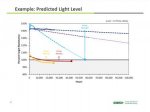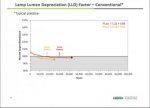I'm a big fan of l.e.d. lighting, and have seen dramatic energy savings at my son's school where I'm still in the process of experimenting.
You're not testing alike. You can expect to save energy by reducing light output.
Classrooms: each has (6) 4-lamp t8 tandem strips, so 24 lamps per room, around 840w. All changed to 18w l.e.d. bypass tubes totaling around 430w and saving 49%. I've calculated savings of around $4.00-7.00 per room depending on usage, which varies. There are 10 classrooms, so around $50 per mo savings.
The wattage values are quite off. Too high by 25%. A 4 lamp T8 standard output ballast uses about 112W. Data is for VEL-4P32-SC with four full wattage lamps. A baseline ballast from early 2000s. The existing system would be around 672W. (645W with the latest prem ballasts)
https://www.platt.com/CutSheets/Philips/PHILIPS_ADVANCE_REL1P32SC35I.pdf
If you're using average RE80 lamps rated at 2950 initial 2800 design lumens deliver 2485 maintained lm on a 88% common ballast. (this is not lumen loss, this is ballast factor) 112W/10000 lm (89 lm/W) <-- this is your current baseline. The base RE70 lamps are no longer made.
The 18W integral ballast LED lamps are not all the same and output can be anything from 1700-2200 with varying durability. the highest standard like 70,000hr (to 30% degradation) DLC qualified and 2,200 lumen output are extremely costly. If you start at 2,200 lumen new, you can expect it to be at 1,785 lumen per lamp or 72W/7,140 lumen per.
That common ballast from early 2000s will run 4 lamps at 88% as well as 3 lamps at 1.0 BF for 94W. Simply remove any one lamp.
Instead of LEDs, use super premium T8 like Advantage 841 which is 3100 new, 2950 design(without expectation of further degradation). The utility power to lamp ratio is now:
94W input/ 8,850 maintained lumens.
So, the LEDs will produce the same number of lumens new as super T8 RE80 that's half way into its life while using 24% less watts.. but this is initial lumen. After half way into LED's life, you can expect it to drop from 8800 lumens to 7,140 lumens. Since delamping one makse it much closer to LEDs output wise, the base line should be 564W... what the fixtures draw if you were to delamp 1 lamp per fixture.
You could go around and replace all the 100W A-bulbs with 43W A-halogen and claim 57% savings. What you end up with is compromising performance to 60w normal bulb equivalent. This kind of approach is often unacceptable as many somewhat modern systems are considerably leaner than systems that were over engineered for lighting performance when energy was dirt cheap.
What you have now is a 35% reduction in input wattage without any regard for light output since all you're doing is matching socket for socket with inferior output product.
HPT8 maintains 90-92% for the life of lamp and the depreciation curve is like a shallow lipped pie plate. LED products are marketed at initial lumens and aside from quartz Metal Halide, LEDs have the highest lumen loss of currently used light sources with 30% loss over their rated life. To maintain target level until the rated life, you need a 43% upsize. In other words, LEDs must produce 1,430 lumens per 1,000 lumens needed to achieve target level to design for long term performance.
Anyone can swap light bulbs around and change wattage, but human eyes do not respond linearly and we tend to easily overlook losses on the output side. For example, if fixtures were wired 4=3+1, shutting one off would be perceived as 15% reduction in output even though the output is actually 25% reduced. The first step is to not turn on the second switch if the excuse is "why does it matter if you don't really notice it?" and that should be the baseline used for energy upgrades. Savings accomplished through reduction in output can't be credited to another technology.
You also have to consider the calculated useful life of the existing system. The material cost, environmental impact, and labor cost.
A routine energy retrofit calculation error is the over estimation of existing power usage, under estimation of performance. Over estimation of output performance of the new system.
Total bill has gone from around $1,300 per mo to around $850 per mo, but only 1/3 of the savings is from lighting. 2/3 is from hvac
But load shedding through lumen shedding is not really efficiency improvement.



